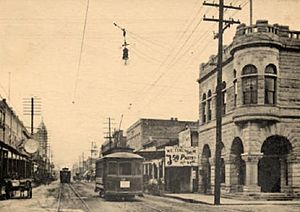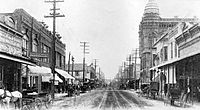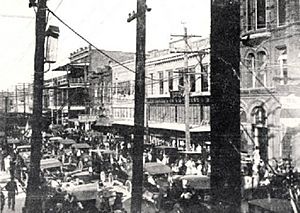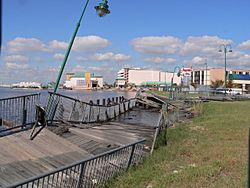History of Lake Charles, Louisiana facts for kids
Lake Charles is a city in Louisiana, USA. It sits on the shores of Lake Charles and the Calcasieu River. This area has a rich history, from its early Native American inhabitants to its growth as a lumber and industrial center. Today, Lake Charles is known for its beautiful lakefront and its role in the energy industry.
Contents
History of Lake Charles
Early Days and First Settlers
Native Americans and European Arrivals
Long before Europeans came, the Atakapa Native American tribe lived in the Lake Charles area. The first European settlers arrived in the 1760s.
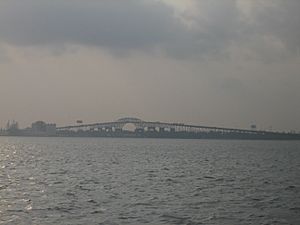
In 1781, Martin LeBleu and his wife, Dela Marion, from France, were the first Europeans recorded to settle here. This area is now called the LeBleu Settlement. Charles Sallier, another early settler, married their daughter, Catherine LeBleu. The Salliers built their home right on the beach where Lake Charles is today.
The land east of the Calcasieu River was once part of a "Neutral Ground" disputed by Spain and the United States. This changed in 1821 with the Adams-Onís Treaty. A famous pirate named Jean Lafitte even brought stolen goods and people to sell in this area. By 1860, the town was known as Charles Town, named after Charles Sallier.
The river flowing through Lake Charles was called Quelqueshue by Native Americans, meaning "Crying Eagle." This name later became "Calcasieu," which is now the name of the local parish (like a county). On March 7, 1861, Lake Charles was officially named Charleston, Louisiana.
Growth and Challenges
Lumber Industry and Town Renaming
The town grew slowly until Captain Daniel Goos arrived in 1855. He was from a place called Frisia. Captain Goos started a lumber mill and a dock for his ships, in an area now known as Goosport. He created a successful trade route, sending his ships filled with lumber to ports in Texas and Mexico. Before Goos, Jacob Ryan was the main person in the lumber business. From 1817 to 1855, selling timber from tall pine and cypress trees was the town's main way to make money.
Jacob Ryan convinced the state government to move the parish seat (the main government office) to Lake Charles. It used to be in a settlement called Marion, about eight miles upriver. Later that year, Ryan and Samuel Kirby moved the courthouse and jail by boat to Charleston. Six years after the town was officially named Charleston, people wanted a new name. So, on March 16, 1867, Charleston, Louisiana, was renamed Lake Charles.
After the Civil War
After the U.S. Civil War, Lake Charles became a major lumber center again. In the 1880s, the city's population and economy grew a lot. This was partly thanks to a clever advertising campaign by J.B. Watkins, which helped the city's population grow by 400% in just ten years!
Using the pine wood from the city's mills, many large and fancy Victorian mansions were built in the 1890s. Carpenters tried to outdo each other with detailed designs and decorations. The area just east of downtown Lake Charles is now called the "Charpentier Historic District." "Charpentier" is the French word for carpenter, and you can still see unique homes from that time there.
Lumber Companies in the Early 1900s
In the early 1880s, wealthy lumber business owners from Michigan, like R. H. Nason and N. B. Bradley, bought huge areas of land in the region. William E. Ramsey, from Canada, also bought land. In 1887, the "Bradley-Ramsey Lumber Company" was formed by these "Michigan Men," who owned over 150,000 acres. They built two sawmills, the Michigan mill and the Mt. Hope mill. The mill owned by J. A. Bel, a local businessman, became the second largest.
By 1912, several large lumber companies were operating in Lake Charles, including J. A. Bel Lumber Company and Calcasieu Long Leaf Lumber Company.
Twentieth Century Changes
On April 23, 1910, a huge fire, known as the "Great Fire of 1910," destroyed much of the city. The courthouse from 1890 and most of downtown Lake Charles were lost. Two months later, the Louisiana government divided the large Calcasieu Parish into several smaller parishes: Allen, Beauregard, Cameron, Jefferson Davis, and Calcasieu. But Lake Charles quickly rebuilt itself and continued to grow.
After World War II, Lake Charles saw a lot of industrial growth, especially with the rise of oil and chemical industries. The Lake Charles Civic Center, built on land reclaimed from the lake in the 1970s, hosted many big shows and famous singers like Elvis Presley. The city's population reached about 80,000 people in the early 1980s. After a local economic slowdown, the population dropped. But with the start of the gaming industry (casinos), the city began to grow again. By the year 2000, the city had a population of 71,757.
Modern Times and Challenges
Hurricane Rita's Impact
Lake Charles was hit hard by Hurricane Rita on September 24, 2005. It was a strong Category 3 storm. On September 22, the mayor ordered everyone to leave the city, and about 90% of residents evacuated. People were asked not to return for 48 hours because of the wind and flood damage. The city's power system was badly damaged, and many areas didn't get electricity back for up to three weeks.
Oil Spill and Recovery Efforts
On June 20, 2006, an oil plant in nearby Sulphur, Louisiana, accidentally released a large amount of oil into the Calcasieu Ship Channel. The United States Coast Guard worked to contain the oil, which had flowed down the Calcasieu River. Because of this accident, the Coast Guard had to close many waterways, including parts of the Calcasieu River Channel and the Gulf Intracoastal Waterway. The Port of Lake Charles was closed for some time due to the pollution.
As part of the city's recovery from Hurricane Rita, city leaders suggested a plan to improve the downtown area. They wanted to make it more appealing and easier for people to walk around. A key goal was to create good, affordable housing. To pay for this, officials proposed a city-wide bond issue (a way for the city to borrow money). About one-third of the 90-million-dollar bond has been spent so far. The Lakefront Promenade and a new marina are currently being built. This money will also be used for other projects across the city.
Recent Hurricanes
In 2020, the city was severely damaged again by Hurricane Laura, a very powerful Category 4 hurricane. Many homes were damaged or destroyed. The Capitol One Building, a tall building in the city, was heavily damaged with many windows blown out. It was later taken down on September 7, 2024.


